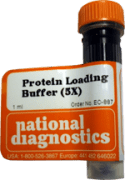Posts by National Diagnostics
Suggested procedures for processing fixed tissue
Here are a few guidelines which you can use to process fixed tissue using Histo-Clear and Histo-Clear II: Histo-Clear Automated Tissue Processing Schedule Process Bath 18 Hour Cycle (Time in Hours) 24 Hour Cycle (Time in Hours) 70% ethanol 1.5 2 80% ethanol 1.5 2 95% ethanol 1.5 2 Absolute alcohol 1.5 2 Absolute alcohol…
Read MoreSmeared Bands
Band distortions are not staining artifacts, they occur during the electrophoretic run. Some of the most common causes are listed below: Particulate in the sample: Standard loading buffers are often unable to completely dissolve complex samples- fragments of bacterial cell walls, for example, can be carried over into the well. Particulate material in the well…
Read MoreBlotches on Gel
Blotches can be caused by overhandling of the gel, or by handling the gel without gloves. This can create uneven surfaces or protein deposits that can bind Coomassie to the gel. To minimize this problem, handle the gel as little as possible, and always with clean gloves. This gel can be recovered in most…
Read MoreUneven Staining
Uneven staining is almost always the result of insufficient agitation during staining. The gel is initially more dense than the staining solution and will tend to sink to the bottom of the dish. Some portions of the gel will have stains under them, others will not, and the gel will show darker and lighter areas…
Read MoreFaint Bands, High Background
A high background which obscures the bands, or in combination with fainter than usual bands, indicates dye binding to the gel matrix, or contamination of the matrix with a dye-binding material (most often a protein). Coomassie Blue R-250: Destaining time too short: It takes hours for the dye to completely diffuse out of the gel…
Read MoreFaint bands, low background
Faint bands over a low background with standard Coomassie Blue R-250 staining can be caused by a number of factors: (scroll down for Colloidal Coomassie troubleshooting) SDS in the staining solution: Most users save and re-use their staining solutions. This is fine for a couple of cycles, but over time enough SDS elutes from the…
Read MoreCoomassie Blue Stain- Troubleshooting
If your gel doesn’t look like this one, click on the problem below to find the solution: Faint bands on a low background Learn More Faint bands on a high background Learn More Uneven Staining Learn More Dark Blotches on Gel Learn More Smeared or blurred bands Learn More The ProtoGel Sample Prep Kit gives…
Read MoreOpticlear Information Sheet
The OptiClear Solvents OptiClear OE-101 OptiClear R OE-102 OptiClear E OE-104 OptiClear S OE-105 OptiClear S2 OE-107 OptiClear W OE-106 Flash Point (oF) 120 142 45 147 177 199 Non-Toxic? Yes Yes Yes Yes Yes Yes Biodegradable? Yes Yes Yes Yes Yes Yes Food Grade Yes No No No No No Evaporation Rate (N-Butyl Acetate=1)…
Read MoreCounting Carbon Dioxide by LSC
Prior to the introduction of liquid scintillation counting, a primary route of radiotracer analysis was to combust the organic material and detect the 14CO2 so generated in a gas phase proportional counter. Many protocols still call for combustion and 14CO2 counting, and many metabolic studies require quantitation of 14CO2 exhaled by tracer-fed animals. 14CO2 is…
Read MoreMeasurement of Radiation and Isotope Quantitation
Most research applications of radioisotopes require an eventual quantitation of the isotope, which is done by measuring the intensity of radiation emitted. Common nomenclature expresses this intensity as disintegrations per minute (DPM). The becquerel (Bq) is the SI unit for radiation, corresponding to 60 DPM (one disintegration per second). The curie, an earlier and still…
Read More


